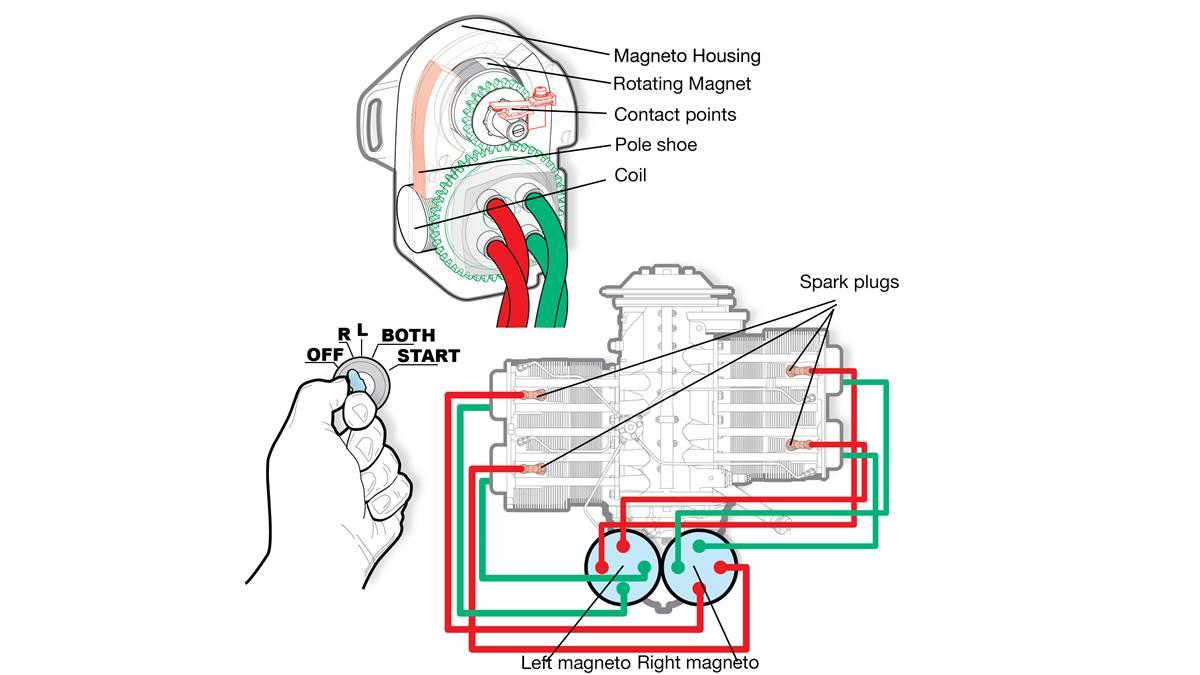Aircraft Magneto - Members Do More Learn More Save More Earn More Being a Pilot Click Here
Technically speaking, magnets are one of the oldest components in a general aviation aircraft, a technology that is over 100 years old. The magneto is a self-contained, high-voltage generator that supplies electricity to the engine through spark plugs. magnet here
Aircraft Magneto

Spinning close to the wire. When the magnet rotates (or the magnetic rotor is turned on), it generates a strong magnetic force that is "recovered" by a primary coil. The moment the contact points open, the fast magnetic flux produces a high voltage in the second coil, which ignites the spark plug, thus starting the engine. The two magnets on the GA manifold - the left and the right - each fire one of the two spark plugs on each cylinder. There are two magnets so that if one of them fails the motor will continue to run, but it will be less efficient. Magnetic ignition systems are primarily used on lawn mowers, chainsaws, and vintage tractors; They have been the power source in light aircraft because they are self-contained and not connected to the battery or electrical systems in the aircraft, allowing the engine to continue running even during a battery or power outage. Historically, the FAA required in-flight lighting to be separate from the battery/lighting system, but newer and better electronic systems are gaining acceptance.
Dln 10 10 88475 1 Bendix Scintilla Mag Magneto Aircraft Radial Engine R 3350 And Other Used Motorcycle Parts
Special Features Editor Julie Summers-Walker joined in 1998. She is a student on her own.
Idea: Maintenance Expert How the cups work: The spark plugs on many piston jet engines are still powered by 120-year-old technology.
Both the Federal Aviation Regulations and their predecessor, the Civil Aviation Regulations, required certified spark-ignition reciprocating aircraft engines—the kind most of us fly after—to have two ignition systems.
Section 33, Section C, states that “every combustion engine shall have two ignition systems with at least two spark plugs per cylinder and two separate electrical circuits with separate sources of electrical power or shall have an ignition system equivalent in aircraft reliability.”
Bendix Magneto Sln 1208 P/n 10 349290 1 Core (0722 301)
There's a good reason for this: electrical system malfunctions are common. Without a properly functioning ignition system, the engine could stall, planes could fall from the sky, and people could be injured. Spark plug failures happen a lot, but the consequences are usually not serious—and often unnoticed—usually because we have two spark plugs per cylinder, and one is enough to keep the cylinder producing power. Usually, the only sign of an aircraft spark plug failure is that the EGT on the affected cylinder rises 50 degrees Fahrenheit or so. You will never notice unless you have a monitor installed on the device and keep it in regular condition. These failures are most often caused by ore getting into the spark plugs, and these failures often resolve themselves. Even when they don't, spark plug faults are often not discovered until the next magneto check, when a failed plug causes excessive magnetic hysteresis.
Magneto failures happen often, but when they do, the consequences can be more serious - or not, depending on the failure. If the mag comes out cold—say, because the breaker fails, the hose opens, or the condenser shorts—the results are negligible: all cylinders continue to fire in single-fire mode, all EGTs rise in one unit, fly to their destination and receive the evil mag firmware. not important.
A failure involving magnetic timing can be critical, especially if the timing is ahead—that is, the spark plugs fire earlier than they should. A magnet that leaks 5 degrees early can send chitagong crosses straight through the roof, and one that leaks 10 degrees early can melt holes in the pistons and cause the cylinder heads to separate. progress.

The worst — and most common — type of mag failure occurs when the plastic dispensing device of the mag fails and begins to drop teeth. When this happens, the magneto can start firing the spark plugs at random times, and the whole thing explodes. The engine starts to run a rough transmission, and unless the pilot throttles way back quickly, the engine can start to stall.
Magneto Ignition Systems
I counted six magnetic distributor failures in two years in a fleet of about 300 GA piston aircraft, and that resulted in one failure per year for 100 aircraft. In my opinion, that's a good failure rate.
This is why the FAA requires that our engines have two magnets. Even if Mag goes berserk, we still have a healthy one to bring us home, right? Don't be sure.
I researched the failures of the 6 magnetic distributor gears thoroughly. They've happened to all types of pilots, from beginners to multi-thousand-hour CFIs, and occur at flight levels ranging from senior to flight level 210. Once a pilot has a means of selecting and closing. Stop magnetic misalignment! This was especially true of the failure on FL210, where an experienced pilot had approximately half an hour to solve the problem as he descended, off, into an emergency landing. In each of these six situations—long time or pilot, high altitude or high altitude—the pilot declared an emergency, pulled power back into service, and landed the aircraft at the nearest airport. Fortunately, all emergency landings are uneventful.
This small plastic magnetic pressure filter can cause a single point failure of the entire ignition system at high altitudes.
Magneto Synchronizer From Aircraft Tool Supply
If these pilots had been trained to deal with such a failure by identifying and shutting down a bad magnet, their engines would have been restarted quickly and their flights could have continued safely to their destination. , at the point where bad magnets can be repaired or repaired. Replace. But none of the pilots did. They all treated the situation as a catastrophic engine failure. Nobody is trying to fix or solve the problem, something simple can easily be done by magnetic closures one at a time until it is identified as bad and malfunctioning.
Bendix D2000 / D3000 dual magnets are used in many Lycoming motors. If the Lycoming engine model number ends in a "D" suffix—for example, O-360-A1F6D or TIO-540-F2BD—one of these PUPs is installed. It is two independent magnets packed in a box, with one drive shaft, pad mounted on the accessory tray. The idea is to reduce real estate and the complexity of the gear train at the rear of the machine. This is probably not Lycoming's best engineering idea. It amazes me how many aircraft owners and mechanics have had bad experiences with these dual magnetos, with some declaring they would never fly a single experimental aircraft equipped with dual magnetos.
The two original D2000s weren't terribly reliable, and many of them were long ago replaced by the much better D3000. Although the D3000 has just about everything—two decoupling points, coils, distributors, and distributor gears—it still doesn't offer the level of redundancy of traditional dual magnets.

One problem area was the bottom clips that attach the mag to the device. They have a history of falling out - either because they were not adjusted properly or because the magnetic mounting flange or motor mounting pad was worn out. When the clamps become loose, the two cups can rotate and the timing of both magnets (not just one) will fail. Another single point failure is the clutch coupling that moves the two cups from the gear train. Lycoming's two mag trigger was one of these, rather than two. Clutch failure can disable the entire ignition system.
Part Bendix Magneto & Parts A Variety Of Cars For Sale
Although the dual magnet meets the letter of the FAA's dual source requirements, I can't help but wonder if it meets the spirit of the regulation. It does not provide the same level of repeatability as traditional double cups.
As if that wasn't bad enough, two of the mugs were only used on Lycomings but were made on Continentals. In 2010, Continental discontinued production and support of the double cups, leaving owners of "-D" Lycomings in a bit of a bind and relying on aftermarket parts sourcing to keep the double cups alive.
Even with a couple of custom cups, a common mode failure can still destroy the entire ignition system. One such failure occurred with a customer of mine who was driving his Cessna 340 in his FL240 when the left engine suddenly stalled and began to vibrate to the point that the pilot was worried he might tear off the wing.
He declared an emergency, requested a high descent, and began an emergency descent. After descending a few thousand feet, the left-hand engine begins to fail, he proceeds uphill, lands safely in his basement, and tells A&P to find out what's wrong.
The Magneto Ignition System
It didn't take the mechanics long to figure out why:
Aircraft magneto ignition system, magneto aircraft ignition, aircraft magneto repair, aircraft magneto switch, aircraft magneto overhaul, aircraft engine magneto, aircraft magneto tester, aircraft magneto parts, aircraft magneto troubleshooting, aircraft magneto bench tester, aircraft magneto timing light, aircraft magneto service
